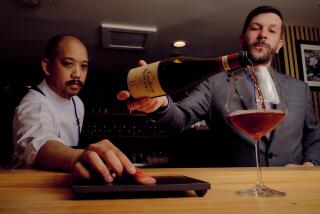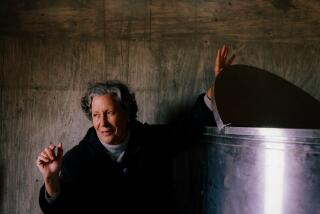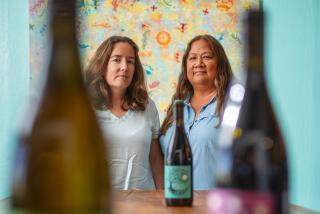Alsace-- With an Italian Accent
Ask a wine snob to name a art of the world where the wines are named for the grape varieties, not for the region, and where German is the main spoken language but not the national tongue.
The snob may well say France’s Alsace district, and you can then nod and say, “Well, I was thinking of another place.”
That place, whose parallels to Alsace are uncannily close, is Alto Adige in the northeastern corner of Italy, a little-understood fine wine region that has even been misnamed in many wine books.
Once part of the Austro-Hungarian empire, Alto Adige (AHL-to AH-dee-jay) formally became part of Italy after World War I when, during the negotiations of the Treaty of Versailles, the area was claimed by Italy.
That placed the picturesque Alpine ski resorts and lush agricultural valleys under a political system that was even more exacting than the one that preceded it, says Urs Vetter, export director for Alois Lageder, one of the finest wine producers in Italy and the leading house of Alto Adige.
The Austrian cultural roots of the people were undermined by what Vetter called “a form of ethnic cleansing.” German personal names were changed to Italian (Josef became Giuseppe) and election ballots were printed in Italian. Even the wines produced here were forced to follow the dictates of the government.
And because the region was made a part of the Italian administrative district called Trentino-Alto Adige, many wine books and articles to this day use that name for the place. But it’s a misleading name. The two areas may be geographically similar, but the more northerly Alto Adige, with its unique ties to Austria and Hungary, really is a world apart from Trentino to the south.
This became clear after the Second World War, when the heritage of Austria and Hungary began to reassert itself here. Names changed back to German; Austrian and Hungarian traditions could be more openly practiced. But many residents assimilated Italian culture with equanimity and even claimed a measure of national sports fame.
For example, look down the roster of the Italian Winter Olympic teams and you see names like Hans, Franz and Horst--not exactly Italianate. More than likely, they are Alto Adigeans living in the palm of the Alps.
Some of this coalescence has led to a lovely Latin/Teutonic marriage. Today, wurst, goulash and pasta sit comfortably on the same table here, and it’s a symbiotic blend no one opposes.
Vetter points out that from 1919 through 1945, officialdom had its effect on the long-term direction of the wine industry too. “After 1919, the government said they wanted us to make red wine, so although we are in the Alps and 93% of the area is higher than 3,000 feet altitude, we had to make red wine,” Vetter says.
White wine is clearly more suitable for the soil and climate, but the result, even today, is that about two-thirds of the wine made in Alto Adige (also known as Sudtirol) is red. Much of it comes from a local grape (Vernatsch, also called Schiava) that produces light, quaffable wines that warm the body after a day on the slopes.
Much of this wine is inexpensive, sold in Austria and Switzerland and does not reflect the great quality of white wine made here from traditional French white grapes. It especially does not reflect the great strides in winemaking that have occurred here in the last decade.
The wines of this tourist region have been sold in the United States for about 15 years, but only recently have truly great wines been made in Alto Adige. Of these, very few are available here.
Burton Anderson, a writer specializing in Italian wines, blames this on the cautious tendency of American importers to select only well-known varietals. “But signs of change,” Anderson writes in the current issue of the Quarterly Review of Wines, “have come from the astute Alois Lageder, who has set up his own importing company to supply U.S. markets with 24 types of wine.”
Tasting through the wines of Lageder, I was struck by the parallels to the Alsace. It was not just that both regions name their wines according to the grape varieties. Both focus on the white wine grapes that do well in cooler regions, like Pinot Blanc, Pinot Gris, Gewurztraminer and Chardonnay.
Moreover, these wines are rarely aged in oak barrels, and when they are, the barrels are not new, so the oak flavoring is minimal. In this sense, these are New Wave wines that focus on flavors of grape, not tree.
Although I liked all of the Lageder wines, the ones that captured my attention most were a stylish 1993 Terlaner Sauvignon Blanc ($13) and a 1994 Pinot Grigio Benefizium Porer ($16).
The former is attractively scented with Granny Smith apple and olive notes and a crisp, tart finish. The latter has a juniper and spiced pear aroma and a mineral, lime and apple taste. A 1994 Chardonnay ($10) has a fresh, apple-like flavor and the sort of acidity I love.
Even Lageder’s red wines are impressive, notably the 1992 Corolle Hirschprunn ($15), a deep, dark, intensely flavored wine that is crisp in the finish. It is mostly Merlot, the remainder Cabernet Sauvignon and Cabernet Franc.
I also like the 1994 Merlot ($14), loaded with black raspberry notes and little tannin to intrude on the palate.
Any Lageder wine will please with food because of the manner in which they are made, and that is why Vetter is finding greater response from U.S. restaurants than from retail shops. In the last 18 months, Lageder’s U.S. sales have rocketed ahead of other producers from Alto Adige, who also are increasing their sales, though more slowly.
One general thought about the white wines of Alto Adige: They are so delicate that serving them too cold will ruin nuances of flavor. And unfortunately, most U.S. restaurants serve all white wines far too cold. So I suggest you allow them to slowly rise in temperature and pay attention to the subtleties. Such wines are rare and should be cherished.
(BEGIN TEXT OF INFOBOX / INFOGRAPHIC)
Wine of the Week
1993 Bonterra Cabernet Sauvignon ($9) --A decade ago, the Fetzer family began an experiment to grow grapes organically, which required much relearning of viticultural practices. It meant eschewing use of pesticides, herbicides and fungicides and implementing many other planting and growing regimes that were time-consuming.
Fetzer soon expanded its experimental organic project. Today the winery’s own acreage includes 360 acres that are certified organic, and the Fetzer family personally owns an additional 1,100 acres that are organically grown.
In 1992 Fetzer released a brand called Fetzer Bonterra for a line of wines that would be entirely produced from organically grown grapes. Recently the name Fetzer was reduced in size on the label, making the brand appear to be Bonterra.
This is the most successful line of organic wines I have tasted, and this Cabernet Sauvignon is excellent. However, it’s odd in that it doesn’t have a great deal of Cabernet character.
Dennis Martin, who heads up an excellent winemaking team, admits that the wine, despite being 87% Cabernet Sauvignon, seems to have more the character of Syrah, of which the wine has only 5%. The aroma is deeply aromatic with an aroma of blueberries, hints of wet earth, herbs and black cherries. It has excellent fruit yet has a faintly gamy taste.
It may not be a classic Cabernet Sauvignon in taste, and it may not be to everyone’s liking, but it’s certainly an intriguing wine worth a try.
More to Read
Sign up for Essential California
The most important California stories and recommendations in your inbox every morning.
You may occasionally receive promotional content from the Los Angeles Times.










